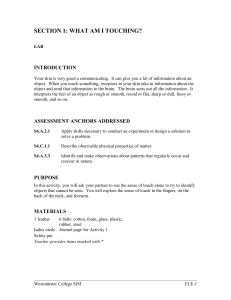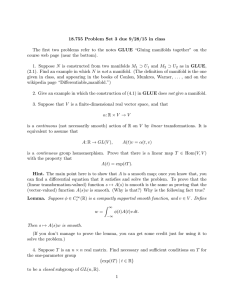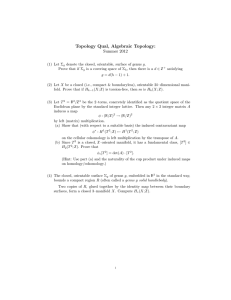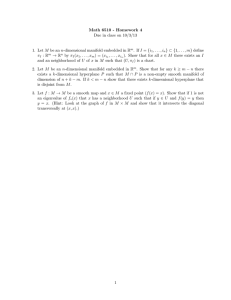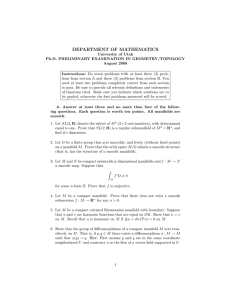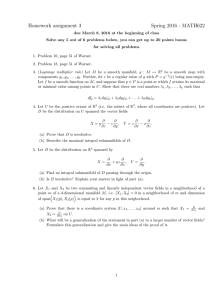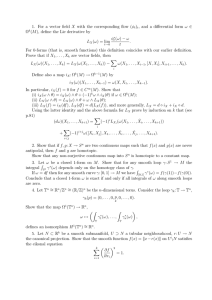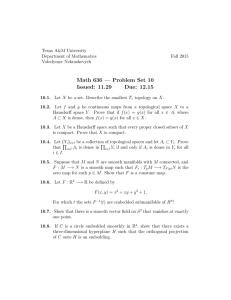Math 147, Homework 4 Solutions Due: May 1, 2012 → R
advertisement
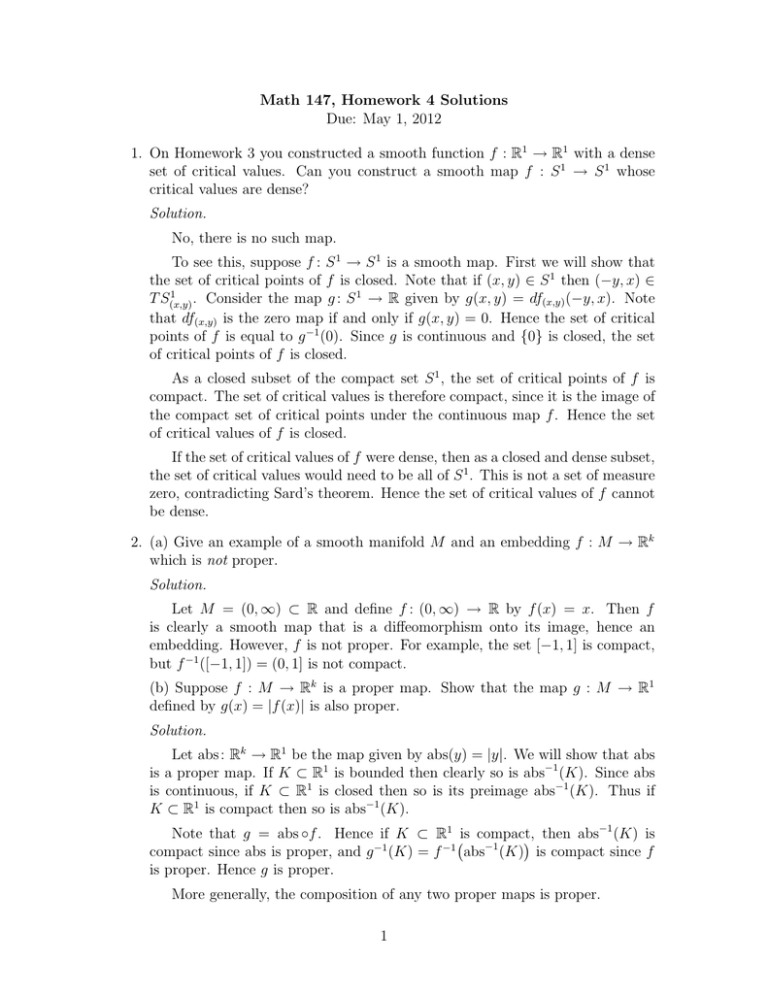
Math 147, Homework 4 Solutions
Due: May 1, 2012
1. On Homework 3 you constructed a smooth function f : R1 → R1 with a dense
set of critical values. Can you construct a smooth map f : S 1 → S 1 whose
critical values are dense?
Solution.
No, there is no such map.
To see this, suppose f : S 1 → S 1 is a smooth map. First we will show that
the set of critical points of f is closed. Note that if (x, y) ∈ S 1 then (−y, x) ∈
1
T S(x,y)
. Consider the map g : S 1 → R given by g(x, y) = df(x,y) (−y, x). Note
that df(x,y) is the zero map if and only if g(x, y) = 0. Hence the set of critical
points of f is equal to g −1 (0). Since g is continuous and {0} is closed, the set
of critical points of f is closed.
As a closed subset of the compact set S 1 , the set of critical points of f is
compact. The set of critical values is therefore compact, since it is the image of
the compact set of critical points under the continuous map f . Hence the set
of critical values of f is closed.
If the set of critical values of f were dense, then as a closed and dense subset,
the set of critical values would need to be all of S 1 . This is not a set of measure
zero, contradicting Sard’s theorem. Hence the set of critical values of f cannot
be dense.
2. (a) Give an example of a smooth manifold M and an embedding f : M → Rk
which is not proper.
Solution.
Let M = (0, ∞) ⊂ R and define f : (0, ∞) → R by f (x) = x. Then f
is clearly a smooth map that is a diffeomorphism onto its image, hence an
embedding. However, f is not proper. For example, the set [−1, 1] is compact,
but f −1 ([−1, 1]) = (0, 1] is not compact.
(b) Suppose f : M → Rk is a proper map. Show that the map g : M → R1
defined by g(x) = |f (x)| is also proper.
Solution.
Let abs : Rk → R1 be the map given by abs(y) = |y|. We will show that abs
is a proper map. If K ⊂ R1 is bounded then clearly so is abs−1 (K). Since abs
is continuous, if K ⊂ R1 is closed then so is its preimage abs−1 (K). Thus if
K ⊂ R1 is compact then so is abs−1 (K).
Note that g = abs ◦f . Hence if K ⊂ R1 is compact,
then abs−1 (K) is
compact since abs is proper, and g −1 (K) = f −1 abs−1 (K) is compact since f
is proper. Hence g is proper.
More generally, the composition of any two proper maps is proper.
1
3. Let T = S 1 × S 1 be the torus and consider the smooth map π : R2 → T defined
by:
π(x, y) = (sin(2πx), cos(2πx), sin(2πy), cos(2πy)).
For which lines L in R2 is the restriction of π to L a one-to-one immersion? For
which lines L is π(L) a smooth manifold? For which lines L is π an embedding?
Solution.
Let L be the line y = mx + b. We claim that π is one-to-one if and only if
m is irrational. Let (x, y) 6= (x0 , y 0 ) be two points in L. So y − y 0 = m(x − x0 ).
We have π(x, y) = π(x0 , y 0 ) if and only if the two conditions x − x0 ∈ Z and
y − y 0 ∈ Z are satisfied. These two conditions cannot both be satisfied if m is
irrational, and hence π is one-to-one if m is irrational. Conversely, if m = pq is
rational for p, q ∈ Z, then these two conditions are satisfied by picking x−x0 = q
and y − y 0 = p. So π is not one-to-one if m is rational.
We calculate
dπ(x,y)
2π cos(2πx)
0
−2π sin(2πx)
0
.
=
0
2π cos(2πy)
0
−2π sin(2πy)
This derivative is injective when restricted to any one-dimensional linear space
in R2 . Hence π is an immersion when restricted to any line L in R2 .
In summary, the restriction of π to L is a one-to-one immersion if and only
if the slope m is irrational.
If slope m is irrational then π(L) is not a smooth manifold. To see this, let
z ∈ π(L). The intersection of π(L) with any sufficiently small open set in R4
about z contains an infinite number of path-connected components. Hence no
neighborhood of z in π(L) is diffeomorphic to any Euclidean space, and so π(L)
is not a smooth manifold.
If slope m is rational then π(L) is a smooth manifold. If m = pq where p and
q are relatively prime, then π(L) wraps regularly p times around one copy of S 1
and q times around the other. For any point z ∈ π(L) there exists a sufficiently
small ball about z whose intersection with π(L) is diffeomorphic to the open
line segment (0, 1). Hence π(L) is a 1-dimensional smooth manifold.
In summary, π(L) is a smooth manifold if and only if slope m is rational.
Map π is an embedding for no lines L. If slope m is rational then π is not
one-to-one and hence π is not an embedding. If slope m is irrational then π(L)
is not a smooth manifold and hence π is not an embedding.
4. Prove the Whitney Immersion Theorem: Every m-dimensional manifold M ⊂
Rk admits an immersion in R2m .
Solution.
2
We will modify the proof of the theorem on page 51 of Guillemin and Pollack:
instead of using both their map h and g, we will only use g but not h. This will
allow us to produce an immersion in R2m , though the immersion need not be
injective.
We shall produce a linear projection Rk → R2m that restricts to an immersion of M . Proceeding inductively, we prove that if f : M → Rn is an
immersion with n > 2k, then there exists a unit vector a ∈ Rn such that
the orthogonal complement of a is still an immersion. Now the complement
H = {b ∈ Rn : b ⊥ a} is an n − 1 dimensional vector subspace of Rn , hence
isomorphic to Rn−1 ; thus we obtain an immersion into Rn−1 .
Define the map g : T (M ) → Rn by g(x, v) = dfx (v). That this map is
smooth follows from problem #8. Since n > 2k, Sard’s theorem implies that
there exists a point a ∈ Rn that’s not in the image of g, and note that a 6= 0
since 0 is in the image of g.
Let π be the projection of Rn onto the orthogonal complement H of a. We
will show that π ◦ f : M → H is an immersion. For suppose not. Then there is
some nonzero vector v ∈ Tx (M ) with d(π ◦ f )x (v) = 0. Because π is linear, the
chain rule yields d(π ◦ f )x = π ◦ dfx . Thus π ◦ dfx (v) = 0, so dfx (v) = ta for some
scalar t. Because f is an immersion, t 6= 0. Thus g(x, 1t v) = a, contradicting
the choice of a. Hence π ◦ f : M → H is an immersion.
So by induction we have produced an immersion of M in R2m .
5. Give an example of a smooth map f : D2 → D2 with no fixed point on the
interior of D2 .
Solution.
Let f : D2 → D2 be the constant map defined by f (x) = (1, 0) for all x ∈ D2 .
Note that f is smooth because it can be extended to a smooth constant map
given by the same formula on all of R2 . Clearly (1, 0) is the only fixed point
of f , and since (1, 0) is not in the interior of D2 , we have found a smooth map
with no fixed point on the interior of D2 .
6. Show that T S 1 is diffeomorphic to S 1 × R.
Solution.
1
1
Note that if (x, y) ∈ S 1 then (−y, x) ∈ T S(x,y)
. Moreover, we have T S(x,y)
=
{(−ty, tx) | t ∈ R}. Hence we have
T S 1 = {(x, y, −ty, tx) ∈ S 1 × R2 | t ∈ R}.
Define f : S 1 × R → T S 1 by f (x, y, t) = (x, y, −ty, tx). Note that f is a
bijection. Map f is smooth because it extends to a smooth map given by the
3
same formula on all of R2 × R. Since the
1
0
df(x,y,t) =
0
t
derivative
0
0
1
0
−t −y
0
x
is nonsingular so long as (x, y) 6= (0, 0), map f is a local diffeomorphism by the
Inverse Function Theorem, and hence f −1 is smooth. So f : S 1 × R → T S 1 is a
diffeomorphism.
7. Prove Brouwer’s Theorem for continuous maps on [−1, 1] directly, without using
regular values.
Solution.
Suppose f : [−1, 1] → [−1, 1] is a continuous map. We must show that f
has a fixed point x with f (x) = x.
We may assume that f (−1) > −1, for otherwise −1 is a fixed point. Similarly, we may assume f (1) < 1. Consider the function g : [−1, 1] → R defined by
g(x) = f (x) − x. Note that g is continuous, that g(1) < 0, and that g(−1) > 0.
By the intermediate value theorem there exists a point x ∈ [−1, 1] with g(x) = 0,
which means that f (x) − x = 0 and f (x) = x.
8. Let f : M → N be a smooth map between manifolds and define df : T M → T N
by:
df (x, v) = (f (x), dfx (v)).
Show that df is a smooth map between manifolds. Show that if f is a diffeomorphism, then so is df .
Solution.
See the third paragraph on page 50 of Guillemin and Pollack for a proof
that df is a smooth map between manifolds. See the fourth paragraph of page
50 for a proof that if f is a diffeomorphism, then so is df .
4
